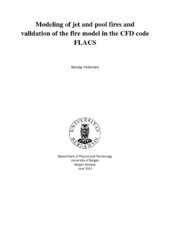| dc.description.abstract | Accidental fires can result in damage of property; endanger people, environment and lead to large economic loss. As a result, predictive estimation of properties describing fire is essential for emergency planning, control and for setting up safety mitigations. Different scenarios of full-scale and small-scales fires can be studied by experiments or Computational Fluid Dynamics (CFD) modeling. The fires of full-scale may be difficult and very expensive to perform by experiments. The extrapolation of small-scale models to full-scale models is often unavailable. Therefore, there is need to develop computational tools capable to model both small and larger fires, where combustion process is complex. The main focus of this thesis is to validate the fire model in FLACS code (FLame Accelerator Simulator) which is under development. The FLACS code is a 3-D Computational Fluid Dynamics code which solves the compressible conservation equations for mass, momentum, enthalpy and mixture fraction using a finite volume method. Fire simulations include such processes as buoyancy, convection, entrainment, turbulence, diffusion, combustion and thermal radiation. Therefore, the use of the following models is necessary in numerical simulations of fire: combustion models, turbulence models, radiation models, soot models and conduction in structures. In the present work, the modeling of turbulent diffusion flames of propane jet and ethylene jet fires and heptane pool fires was performed using the FLACS-Fire code. The experiments with most relevant and available data from the literature were used for validating of the model modeling. The Eddy Dissipation Concept (EDC) was used to model the combustion. Turbulence was modeled using the k-epsilon model. Radiation was handled using the Discrete Transfer Model (DTM). The predicted results of flame height, temperature, soot volume fractions were compared with experimental measurements and simulated results of other authors. The grid sensitivity and parametric analysis were performed in simulations of jet fires. The finest grid size was equal to the one leak cell within the flame domain. Outside the flame domain the grid was stretched towards the boundaries. The changes in such parameters as time step length, turbulence length scale and number of rays in radiation model were tested in simulations of basic case which represented the best predicted results. The predicted results of temperature in ethylene jet fire with finest grid resolution were in good agreement with experimental measurements. The results of temperature were strongly influenced by changes in relative turbulence intensity in the jets. The importance of radiation was tested and showed that the predicted temperatures were significant dependent on radiation modeling. The flame heights were over-predicted for all propane jet flames. FLACS-Fire was unable to predict lift-off distance which could have influence on prediction of the flame height. The prediction of soot volume fractions was reasonable in comparison to experimental measurements. The simulations of heptane pool fires showed that the FLACS-Fire was able to model pool fires. The predicted temperatures at the centerline of flame were over-predicted comparing to experimental measurements. The modeling of pool fire using FLACS-Fire gave very rough approximation to the real pool flame. The consideration of buoyancy and heat feedback effect in the numerical simulations is necessary for reasonable modeling of pool flame | en_US |
